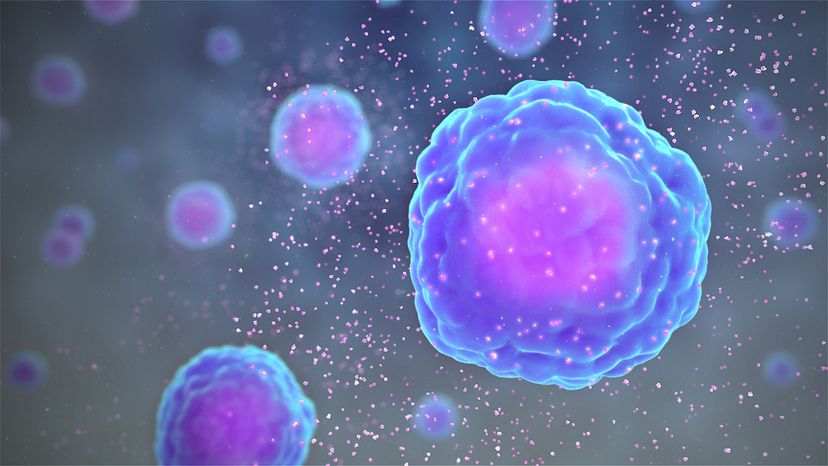 “3D animation still depicting the secretion of cytokines, or watchdog molecules, into the blood from the body’s immune system. Wikimedia Commons (CC BY-SA 4.0)
“3D animation still depicting the secretion of cytokines, or watchdog molecules, into the blood from the body’s immune system. Wikimedia Commons (CC BY-SA 4.0)
Every one of your biological systems is important — your digestive system absorbs nutrients and gets rid of waste, your respiratory system absorbs oxygen and removes carbon dioxide, your muscular system allows you to move. But the immune system has the essential and complicated job of defending your body from outside threats, while, you know, not overdoing it. It’s the "not overdoing it" part that’s sometimes difficult for the immune system.
Immune Response Gone Wild
Take the immune condition called "cytokine storm," in which the immune system completely overreacts to the virus or bacterial infection it’s trying to fight, attacking the organs and sometimes killing the body it’s working to protect.
Cytokines are a class of signaling molecules used by the body to regulate things like immunity and inflammation. These proteins travel around the body through the blood, telling the immune system to slow down or ramp up its defense response. Once cytokines realize an immune response is necessary to fight a particular enemy invader, they get to work spreading the news. And, normally, when it’s time to dial back the intensity of the attack, cytokines share that information with the immune system as well. Except in cases when they don’t.
"Most of the time, the immune system ramps up to clear an infection, and then it calms itself down," says Dr. Randy Cron, professor of Pediatrics & Medicine at the University of Alabama at Birmingham and co-editor of the first-ever textbook on the subject, titled "Cytokine Storm Syndrome," in an email interview. "In cytokine storm syndrome, an inappropriate response occurs so that the immune system keeps fighting, thus causing damage to the infected person."
Cytokine Storms and COVID-19
Doctors are finding signs of cytokine storm in many of the most dire coronavirus cases. Higher levels of cytokines are common in the most severe cases of the disease, especially in those who are young and healthy. A patient who would normally be expected to push through a virus or infection relatively well given their age and overall health might suddenly become dangerously sick within a very short period of time.
"Cytokine storms can affect any age from infancy on up through adulthood," says Cron. "For COVID-19, it appears as if children may be relatively spared the cytokine storm syndrome compared to adults."
According to Cron, there are some therapies to help the patient deal with their immune system dangerously overdoing it, but it’s a relatively new area of research, and information isn’t always disseminated equally among health professionals treating people with COVID-19. Cron estimates that as many as 15 percent of people fighting off serious infection will also contend with cytokine storm syndrome.
Cytokine storms can occur in patients of any age, but some doctors believe they might provide an explanation for why the 1918 pandemic killed so many people in the normally resilient 20-40 year old age group. Researchers also think they can see the signature of cytokine storms in more recent SARS, MERS and H1N1 epidemics, but why aren’t we seeing them more with everyday illnesses like the common cold?
"Certain viruses are more likely to trigger cytokine storm syndrome than others, including COVID-19," says Cron. "It is rare with common colds, but certainly can happen with bad strains of the flu virus and even hemorrhagic fever virus like Ebola or Dengue."
What to Watch Out For
Although our understanding of cytokine storms is evolving, they seem to have some unique traits when under the influence of the COVID-19 virus. For instance, some of the specific cytokines often seen spiking in patients suffering from other viruses like H1N1 or SARS are kept lower with this coronavirus, but the storm comes on more quickly and blood clotting rates are higher. Cron and his colleagues suspect some genetic factors might explain certain types of cytokine storms in some patients. But for now, we just have to watch out for our sick friends:
"This particular COVID-19 cytokine storm syndrome appears to primarily target the lungs at first," says Cron. "Beyond just a fever and cough, cytokine storm can develop when it becomes increasingly more difficult to breathe."
Research In the area is evolving quickly and some experimental therapies are showing a lot of promise. For instance, the drug tocilizumab (generally used for calming down overactive immune responses) is showing a lot of promise as a therapy to treat cytokine storm syndrome in COVID-19 patients.
Now That’s Interesting
A cytokine storm may be accompanied by symptoms such as an abnormally fast heart rate and a drop in blood pressure.


